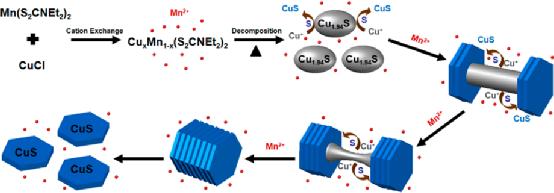Compared with noble metal or rare elements, copper sulfides should be an economical candidate for optoelectronic devices or photocatalyst. However, current research has always kept their eyes on single phase of copper sulfides. As a result, exploring the possibility of heterojunction in polymorphs will be a challenge but exciting task. A research team led by Pro.YU Shuhong and Pro.LI Zhenyu from Hefei national laboratory for physical sciences at the microscale achieved a progress in self-coupled sulfide polymorphs.
Quantum effect depends strongly on nanoparticles’ structures. As a result, the design of their size, shape, and crystal form has always been the hotspot of the researches. Because of the electronic coupling effects between distinct components, heteronanostructure, a classic building block of semiconductor nanocrystals, achieves eminent ameliorations in photogenerated carrier separation and transport.
As an excellent p -type material, copper sulfides (Cu2 − xS) possess wide range of bandgap energy, from about 1.2 eV for chalcocite (x = 0) to 2.0 eV for covellite (x = 1), fitting well with the solar spectrum. Along with the factor X grows, the materials turn into metal from semiconductor, and the surface plasmon resonances (LSPR) enhance at the interfaces of these hybrids.
Self-coupled Cu1.94S-CuS polymorphs were synthesized through one-step hydrothermal method. With the help of manganous precursors, Cu1.94S-CuS polymorphs were formed as the intermediate products of the phase transformation. Density functional theory (DFT) calculations revealed Cu1.94S were formed initially via decomposition because of the lowest crystallization temperature. In the previous researches, the conversion was performed from CuS to Cu2S using a Cu (I) complex. The inverse process was achieved in this study by appropriate “redox regulator”, namely sulfur species. The reaction took place at the tips of egg-like Cu1.94S nanocrystals firstly, which contained active facets. Thanks for the stabilization of formed CuS nanoplates, the dumbbell could be isolated. However, due to the mobility of Mn2+, Cu+ ions diffusion would be accelerated and the handle of dumbbell would be consumed. Finally, the pure nanoplates of CuS appeared.

Figure.Mechanism of the Growth of Cu2-xS Polymorphs(Image by YU Shuhong &LI Zhenyu)
This study was published online in J. Am. Chem. Soc. 2016, 138(39), 12913-12919, as JACS Spotlights, with title “Heteronanostructure Polymorphs with Enhanced Photoelectrochemical Properties”. This colloidal method provides a new insight into the design of metal chalcogenide heteronanostructures for the application of optoelectronic devices or photocatalyst.
The research was supported by the National Natural Science Foundation of China (NSFC), the Foundation for Innovative Research Groups of the National Natural Science Foundation of China, the National Basic Research Program of China and etc.
Contact
Prof. YU Shuhong
shyu@ustcnet.
Prof. LI Zhenyu
zyli@ustcnet.
University of Science and Technology of China
Hefei, Anhui 230026, China
The link of the paper: http://pubs.acs.org/doi/abs/10.1021/jacs.6b06609